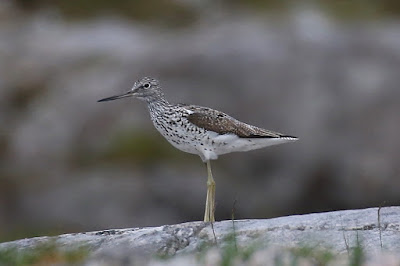Dorset is a something of a dragonfly hotspot but I have visited a few others on recent travels, including on our holiday to the north west of Scotland at the start of the month, an area which hosts a number of species with restricted ranges in the UK. Site guides old and new suggested that Bridge Of Grudie on the southern shore of Loch Maree would be worth a look. Not an easy site to cover with wellingtons being essential to get out to some boggy pools which I had read host the White-faced Darter, though I had almost immediate success with one of my targets on leaving the car and flushing a Northern Emerald in a forest clearing just behind where we had parked.
 |
| Northern Emerald - a female judging by shape of the abdomen - compare to.... |
 |
| ...a male Northern Emerald, which has a more 'waisted' appearance. Note also the calliper-shaped anal appendages. Call me puerile, but it's great to have an excuse to use the phrase 'anal appendages' on this blog again. It's been a while. |
 |
| Lateral yellow spots on the frons also identify this as Northern Emerald - one is just visible here |
I eventually located the pools, which can't be seen from the roadside, but unfortunately there were no White-faced Darters on them and I had to make do with several Four-spotted Chasers and a variety of Damselflies.
James Lowen's A Summer of British Wildlife also suggested checking out a site in Slattadale Forest (where a tantalising glimpse of what was probably a female Azure Hawker left me slightly frustrated) and the Woodland Trail at the Beinn Eighe NNR where a brief but conclusive view of a male Azure Hawker in flight was more satisfactory. Annoyingly, despite heavy rain starting as it floated around a clearing, it just would not land to pose for a photo. Still, two new dragonflies in two days was good going.
 |
| Four-spotted Chaser, Bridge of Grudie |
 |
| Blue-tailed Damselfly, Bridge of Grudie |
 |
| Common Blue Damselfly, Bridge of Grudie |
Within a week or so of returning home to Dorset from Scotland, the chance of seeing another new species arose when Olly Frampton discovered a couple of Lesser Emperor, a rare migrant to the UK, at nearby Longham Lakes. As it was during the recent heatwave, despite the lateness of the hour and some afternoon cloud cover, I felt it was worth a try after work to see if they were still on the wing.
 |
| Lesser Emperor, Longham Lakes - readily identified by the pale blue saddle behind the thorax. |
 |
| This attractive Banded Demioselle was also on the wing at Longham |
 |
| Female Emperor at Longham Lakes - during warm weather the normally green abdomen can turn blue |
Sure enough, with the help of son George and the rest of the family who I had lured to Longham with the promise of pizza on the way home, we found one shortly before 8pm. It didn't settle, so I had to make do with a ropey flight shot as it sped past some lakeside reeds. This run of close encounters with rare dragonflies encouraged me to spend a bit more time photographing them on some recent walks in Wareham Forest - great habitat for
odonata.
 |
| Female Black-tailed Skimmer, Wareham Forest |
 |
| Emperor, Wareham Forest |
 |
| Keeled Skimmer, Wareham Forest |
On one tiny pool in the forest I came across three blue male dragonflies each of a different species - the impressive Broad-bodied Chaser, the slightly less chunky Black-tailed Skimmer and the sleek Keeled Skimmer - testament to how fortunate we are to have all this on our doorstep.
 |
| Broad-bodied Chaser, Wareham Forest |
 |
| Black-tailed Skimmer, Wareham Forest |
 |
| Keeled Skimmer, Wareham Forest |



























































